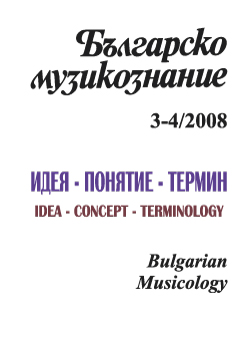Към въпроса за терминологията на византийското осмогласие
On the Question of Terminology for Byzantine Oktoechos
Author(s): Klara MechkovaSubject(s): Music
Published by: Институт за изследване на изкуствата, Българска академия на науките
Summary/Abstract: This article is in honor of Prof. D.Sc. Elena Toncheva’s 75th birthday The Byzantine musical system is a unique phenomenon that reflects Orthodox Christian faith and theology. It has as its basis the idea of phone – a phenomenon that does not have an equivalent in the Western European concepts of sound, whole tone or interval. Phone is a musical space, constituting the smallest logically division part of it, replacing three subelemental levels and in this way acting as a basic building block (unit) of the system. The phone also exists in the context of the theological conception of Divine Light and non-created energies. The dogmatic conception of the Holy Spirit so fundamental to Byzantine Christian thought is projected into this category in a surprising way, as well as into the ison, which also carries the idea of a musical space, i.e. as an emerging phonai and subsequently – music. The term phone is the root of many Byzantine terms such as metrophonia, diphonia, triphonia and tetraphonia; it also serves as the foundation for the names of the classes of neumic signs at the basis of medieval musical notation – phonitika or emphona and aphona, and so forth. Phenomena crucial to Byzantine musical thought and the accompanying terminology – such as the sound quality of phone, tetraphonia, the melos of the sound, and the polysyllabic names for the sounds – are unique to the Byzantine musical system. The structural unit in the form of optimal and maximal tetraphonia, as well as the system’s two principles – of corresponding pairs of phone and circular movement – serve as the basis for the unique phenomenon that is phone. The principles allow for the „qualitatively different“ covering of one and the same sonic space in ascending and descending directions and for circular movement into neighboring sonic spaces (maintained by phone). They are also re-created on the level of oktoechos: the function of the principle of corresponding pairs of phone sets the main and plagal voices in the same vertical sound space (i.e. it presents them as static); the function of the circular principle finds expression in the specific separation of the voices into pairs, through which the principle introduces the potential for „movement“ and hence the possibility for capturing the entire musical space. The principle of circular movement expresses the deepest essence of the system and is the reason it is called Trochos (The Wheel). In fact, through these two unique principles, the system’s exceptional unity and perfection is realized in a theoretical sense..
Journal: Българско музикознание
- Issue Year: 2008
- Issue No: 3-4
- Page Range: 60-87
- Page Count: 28
- Language: Bulgarian
- Content File-PDF

